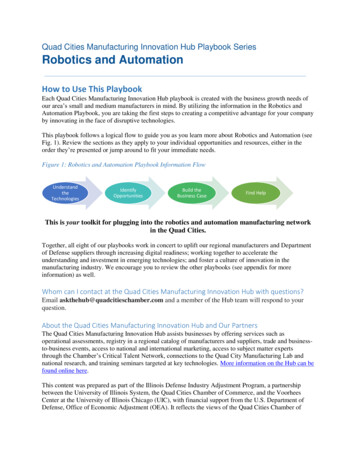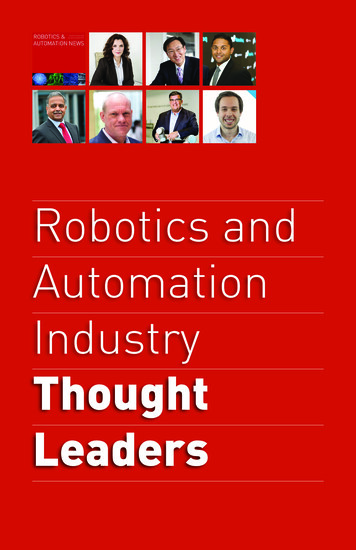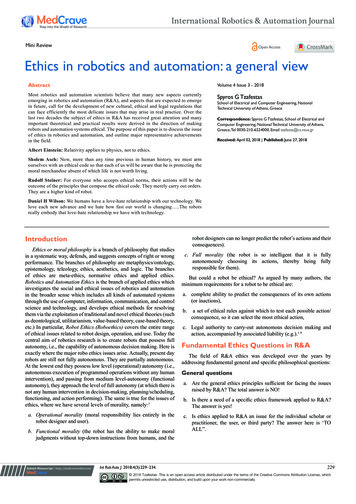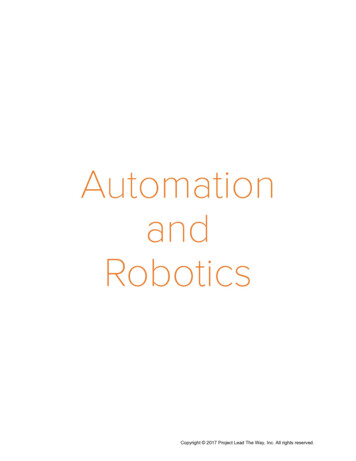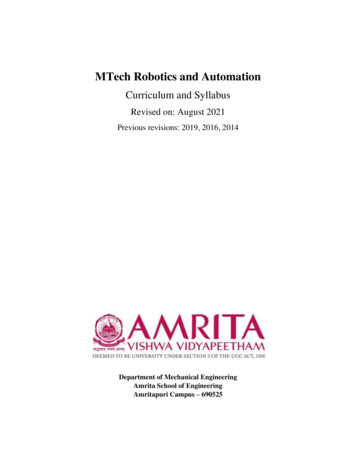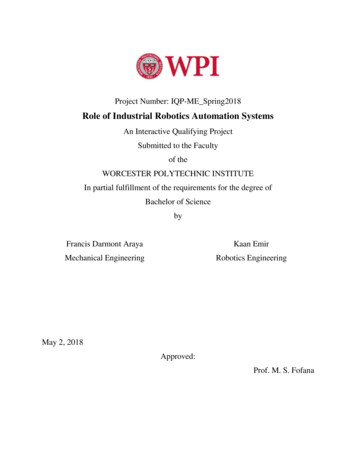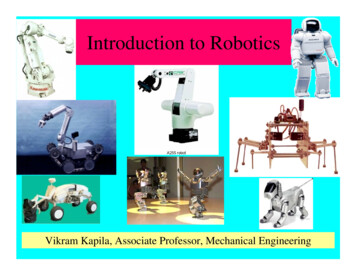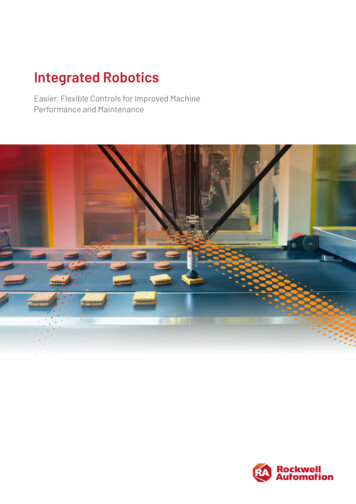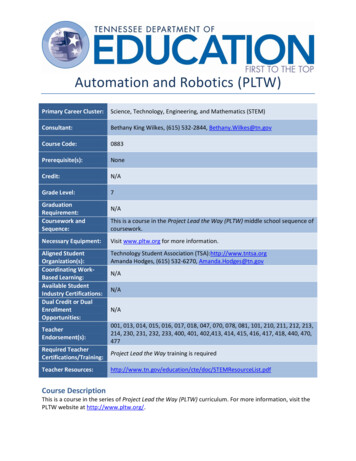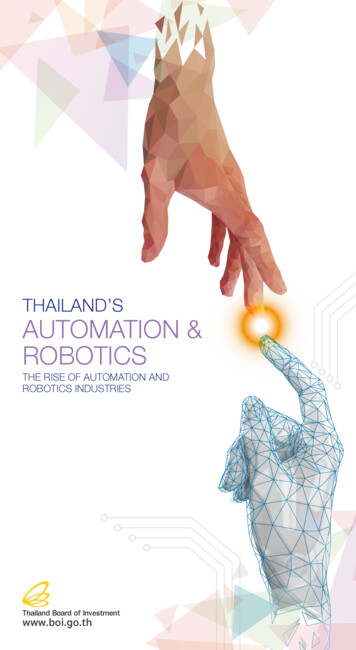
Transcription
Beach Cities RoboticsFIRST Team 294Automation and RoboticsIntroductory Robotics Lectures for BCR Summer CampCopyright 2004 by Beach Cities Robotics Team 294, all rights reserved.All images here are fair use for educational purposes.Attributions are given where available.Rick WagnerVersion 1.06, July 23, 2004.1 What is Automation?People build automatic devices so that they have less work to do for the same gain, or sothat their capabilities are expanded. Automated artifacts are literally labor saving devices.1.1 Examples of AutomationWe can illustrate automation by giving some examples.1.1.1 TransportationA wheeled cart is not automation, but the wheel is an important design feature allowingautomation.1.1.1.1 Iron Horses and Horseless CarriagesThe steam engine was an important advance in the history of technology. James Wattcreated a steam engine that produced rotary motion suitable for driving wheels. Thisenabled transportable steam engines, many of which were put on rails allowing vastimprovements in transportation efficiency.Page 1
Beach Cities RoboticsFIRST Team 294Figure 1: Steam locomotive.When engines and wheels were freed from the railroad tracks, the machines came to becalled “automobiles.” These still were not what we would today call “automated” butthey were getting closer.1.1.1.2 SkyscrapersIn the 19th century, a man named Elisha Otis invented a fail-safe device for elevators,which he demonstrated at the 1853 New York World’s Fair. Previously, elevatoraccidents had prevented them from becoming popular; so most buildings were under fiveor six stories tall. After the Otis elevator was invented, buildings began to be built tallerand taller. In the 20th century, buildings over 20 floors high became common.Figure 2: New York World's Fair, Crystal Palace Exposition.Image by Otis Elevator.Page 2
Beach Cities RoboticsFIRST Team 294Figure 3: Crystal Palace, New York, 1853.Page 3
Beach Cities RoboticsFIRST Team 294Figure 4: Otis has himself hauled up in his elevator platformand has an assistant cut the rope in front of the gatheredspectators.With very tall buildings with many occupants and several elevators, automated elevatorswith scheduling algorithms help to minimize the waiting time for elevator passengers.Page 4
Beach Cities RoboticsFIRST Team 294Figure 5: The Empire State Building's 73 elevators can move600 to 1,400 feet (183 to 427 meters) per minute. At themaximum speed, you can travel from the lobby to the 80thfloor in 45 seconds. Photo and caption copyright 2001 byHowStuffWorks, fair use for educational purposes.1.1.2 ManufacturingEli Whitney invented interchangeable parts making mass production possible (batchmode). Henry Ford implemented an assembly line (pipeline flow) for even greaterefficiency. Manufacturers are replacing human workers with robots in the dirtier andmore hazardous jobs such as welding and painting.Page 5
Beach Cities RoboticsFIRST Team 294Figure 6: First Ford assembly line, 1913.2 Robotics: Flexible AutomationMost manufacturing automation is called fixed automation. A stamping machine canstamp only one kind of sheet metal part without being retooled, for example, or a boringmachine bores only one kind of hole in one kind of part. When robots are part of anautomatic process, the process can be changed by changing the programming of therobots. Robotic automation is called flexible automation.Page 6
Beach Cities RoboticsFIRST Team 294Figure 7: Welding robots at a Toyota automobile factory.2.1 Definition of AutonomyEveryone should be familiar with the automatic toaster, a common home appliance.Bread is put in the toaster, a lever is pushed down, and when the toast is done, it shuts offand pops up automatically. The toaster is automatic, but not autonomous.Figure 8: Hearth Toaster from the Walter Himmelreichtcollection, Pennsylvania, c. 1800. Bread was placed betweenthe arches; when one side was browned, the toaster wasrotated to brown the other side. Photo and caption from theCyber Toaster Museum.An autonomous toaster would have a more flexible capability. It would have a way ofknowing what kind of bread was in it and how well done the user wants the toast, so itcould adjust the heat accordingly. It would be able to monitor the toasting process so thetoast would always be fully done and never burned. Autonomy is a smarter kind ofautomation.Page 7
Beach Cities RoboticsFIRST Team 294Figure 9: Sunbeam, Model T-20, from the late 1940s throughthe mid 1950s. This was the first "fully automatic" toaster.When bread is placed into this toaster, it is automaticallylowered; when the toasting cycle is complete, the unit shutsoff and gently raises the toast for removal. Photo andcaption from the Cyber Toaster Museum.Definition: Autonomy is the ability of a system to perform successfully for extendedperiods without human intervention.2.2 Examples of RobotsThe earliest movie robot was Maria in the 1927 silent film Metropolis. Maria’s builder,Rotwang, solved the intelligence programming problem by transferring the mind of thehuman Maria into the robot.Figure 10: Maria the robot from the 1927 silent filmMetropolis, with Rotwang, the robot’s creator.Robots remained in the realm of science fiction until the 1960s with Marvin Minsky’sBlocks World at MIT and Shakey the robot at Stanford.Page 8
Beach Cities RoboticsFIRST Team 294Figure 11: Shakey the robot, Stanford University, 1970.2.3 Definition of RobotA robot is an autonomous artifact that obtains information by sensing the world around itand uses the information to manipulate its environment to achieve goals. Robot sensingincludes vision, sound, touch, and others. Manipulation includes the use of specializedtools and dexterous manipulation. Robots often have the ability to change their locationsin the world (locomotion).Page 9
Beach Cities RoboticsFIRST Team 294Figure 12: Executive of the Future, Boris Artzybasheff, 1947.2.3.1 Features of a RobotRobots are designed to have the features appropriate to their functionality.Page 10
Beach Cities RoboticsFIRST Team 294Figure 13: Robot for laser cutting, welding, and drilling.2.3.1.1 MobilityNot all robots are mobile, but mobility is a very useful feature for many applications.However, mobility imposes mass and power constraints on a robot.Figure 14: RoboX tour guide robot from BlueBotics,Switzerland.Page 11
Beach Cities RoboticsFIRST Team 294Wheels provide the easiest form of mobility to implement, but require relatively smoothterrain. Legged robots borrow their solution from nature, and improve capability onrough ground, but are notoriously difficult to implement. Tracks (as on military tanks) area good compromise.Mobility might also include the ability to fly or swim, or in the case of space robots tochange trajectory or orientation with rocket thrusters.2.3.1.2 SensingFigure 15: Six axis robot arm from Adept Robotics, SanJose, California.If robots didn’t have autonomy, they wouldn’t need sensing. They could have all theiractions pre-programmed into them, but their capabilities would be considerably limited.With sensing, the robot must use the information acquired from the sensors in decidingwhat to do next.The information from the sensors will only make sense if the robot has some way ofusing the information to create or modify a model of the world. The process of usingsensor data is called representation. Representation and decision making requireintelligence.2.3.1.3 IntelligenceOne common approach to robotics is to use a sensing-action cycle. The robot takes sensordata to build or modify a model of the world around it. Then it uses its objectives (goals)to decide how to operate on the world model to achieve a particular goal or sub-goal.Then it performs the action and repeats the cycle.Different robot applications require different intelligence strategies. Some applicationsrequire complex planning algorithms. Others where speed is important have simple andfast programs.Page 12
Beach Cities RoboticsFIRST Team 294Figure 16: A Segway RMP providing ISAAC with a Barneydoll. Vanderbilt University Center for Intelligent Systems.Anthropomorphic robots have long been a research area in which the application requiressophisticated artificial intelligence (AI) involving binocular image recognition to build3D models of the world and voice recognition for conversing with humans.2.4 Robotics DisciplinesRobotics researchers and engineers work in several areas or disciplines within robotics.2.4.1 NavigationNavigation algorithms are generally applicable to mobile robots. Robots evaluate theircurrent position from sensor data and construct a plan for moving to a goal or way-point(sub-goal).Page 13
Beach Cities RoboticsFIRST Team 294Figure 17: Model 912 mobile robot from White Box Robotics.A classic example of a navigation problem is to cross a parking lot without running intoany parked cars. Finding a relatively short path is also an objective of this problem.One way to do this is to use the “visibility graph” technique. The conventional visibilitygraph runs in time n2 where n is the number of obstacles in the workspace. A localityheuristic allows us to reduce the computation time to n for workspaces that are notPage 14
Beach Cities RoboticsFIRST Team 294densely populated in obstacles, which is the general case. An application program hasbeen devised to illustrate this heuristic.Figure 18: Visibility graph demonstration program. Therobot is represented by the hexagon in the lower left corner.The goal point is in the upper right corner. The redrectangular obstacles represent cars in a parking lot.Page 15
Beach Cities RoboticsFIRST Team 294Figure 19: The locality is bounded by drawing a line fromthe robot to the goal and then “growing” this line by therobot (Minkowski sum). If the grown line contacts anyobstacles, those obstacles are included in the locality andthe process repeats until no new obstacles are included inthe locality. Here, four obstacles are included in the locality.Page 16
Beach Cities RoboticsFIRST Team 294Figure 20: Next, the local obstacles are “grown” by therobot (take the Minkowski sum).Page 17
Beach Cities RoboticsFIRST Team 294Figure 21: Then we draw the visibility graph of the robot,grown local obstacles, and the goal point.Page 18
Beach Cities RoboticsFIRST Team 294Figure 22: The shortest path in the visibility graph is thenfound using Djikstra’s algorithm.2.4.2 ManipulationManipulation is the area of robotics concerned with finding a good grip (grasping) andthen handling objects so that objectives are met.Figure 23: Commercial dexterous robot hand from theShadow Robot Company.Page 19
Beach Cities RoboticsFIRST Team 294In handling an object, there are a large number of “configurations” of the gripper on theobject. The robot has to know how to compute an acceptable grip. If there is an error, therobot could drop the object it picks up, or won’t be able to properly hand it off or put itwhere it belongs.For example, suppose a robot needs to hand a pan of water to a person or another robot. Ifthe first robot’s hand completely covers the handle, the person or second robot won’t beable to take the pan.2.4.3 Computer VisionAnother very rich and interesting research area is computer vision. This usually requiresconstructing a 3D model of the world based on the images from one or more cameras.Figure 24: MARVIN, a vision research robot at MunchinTechnical University.Many vision systems use “binocular vision” similar to humans. Others use laser rangefinders, sonar, or radar. Stereoscopic vision can be constructed using one camera andmoving it from place to place in the scene to be modeled.2.4.4 Artificial IntelligenceNavigation, manipulation, and computer vision all require artificial intelligence.However, artificial intelligence goes beyond those three strictly robotic disciplines.Realizing the fullest capabilities of robots will require speech understanding and commonsense reasoning.Page 20
Beach Cities RoboticsFIRST Team 294Figure 25: Tiktok, the clockwork man in the children’s storyOzma of Oz, by L. Frank Baum. Tiktok had to be wound upwith a key, one spring was wound for movement, and onespring was wound for thinking.For a robot to communicate with people will require that it have understanding of theworld, or at least understanding of its domain environment. Research projects to achievethis goal have been underway at universities for many years.Figure 26: Rodney Brooks poses with Cog (left), Cog’shand.For example, Rodney Brooks’ goal at MIT is to produce a fully capable anthropomorphicrobot in his Cog project.Page 21
Beach Cities RoboticsFIRST Team 294Figure 27: Cynthia Breazeal with Cog (left), what Cog sees.The Cyc project (http://www.opencyc.org/) has been building a commons sense databasefor machine intelligence for over 20 years.Figure 28: ASIMO, the anthropomorphic robot built byHonda.The Honda Corporation in Japan has created a walking anthropomorphic robot namedASIMO, which stands for Advanced Step in Innovative Mobility. The name probablyalso derives from the late Isaac Asimov who wrote I, Robot and developed the so-calledThree Laws of Robotics, which are actually design guidelines. ASIMO’s maximumwalking speed is currently 1.6 k/h.Page 22
Beach Cities RoboticsFIRST Team 2942.4.4.1 Computer HierarchyThere are two parallel computer hierarchies, a conceptual hierarchy, and a systemhierarchy.2.4.4.1.1 DataThe lowest level of the conceptual hierarchy is data. These are the raw bits, numbers,words, and sequences. Without context, data has little meaning. For example, given thenumber “74” there is very little meaning to it, except for the fact that it’s a relativelysmall integer in base 10 format.2.4.4.1.2 InformationThe level above data is information, which is data in context. For example, if I say “74degrees Fahrenheit at 5:00 PM in Baltimore,” then you know the context of “74,”allowing one to draw inferences.2.4.4.1.3 KnowledgeHaving information about the temperature in Baltimore allows one to infer that one won’tneed to wear a parka if one travels there today. The inference demonstrates that one hasknowledge about temperature, weather, and clothing.2.4.4.1.4 IntelligenceIntelligence is the next step up in the hierarchy, and is the ability to achieve goals basedon knowledge. For example, if I ask a robot to pack my bags for a trip to Baltimore, andthe robot looks up the temperature there and doesn’t pack my parka, then we might saythat the robot exhibits intelligence.2.4.4.1.5 WisdomWisdom is the ability to set the right goals. If I should ask a robot “where should I gotomorrow?” the robot will have no way to answer that question because wisdom isbeyond the capabilities of artificial systems.2.4.4.1.6 HardwareHardware is the lowest level of the system hierarchy. The data are stored in the memorychips and CPU registers.2.4.4.1.7 Operating SystemThe operating system is in direct contact with the hardware and mediates applicationsoftware access to computer resources.2.4.4.1.8 Application SoftwareApplication software is the middle level in the system hierarchy.2.4.4.1.9 Network ProtocolThe network protocol level regulates communication among computers.Page 23
Beach Cities RoboticsFIRST Team 2942.4.4.1.10 PolicyHuman beings set computer policy. Computer access rights and network security featuresare examples of policy.The two computer hierarchies are summarized below in Figure HardwareFigure 29: The two somewhat parallel computer hierarchies.The conceptual hierarchy is on the left and the systemhierarchy is on the right.The human user also interfaces directly with the hardware layer via the keyboard andmouse, so the system “hierarchy” is actually a circle. This is shown below in Figure 30.Page 24
Beach Cities RoboticsFIRST Team 294HardwareorkNetw gure 30: The circular nature of the computer systemrelation. Human beings at the policy level interface with thehardware to complete the cycle.Asimov’s three laws of robotics are an example of policy implementation. In writingrobotic software, the human designer types code on the keyboard. The keystrokes areinterpreted by the operating system and passed to the editing and compiling applications.Page 25
Beach Cities Robotics FIRST Team 294 Page 6 Figure 6: First Ford assembly line, 1913. 2 Robotics: Flexible Automation Most manufacturing automation is called fixed automation. A stamping machine can stamp only one kind of sheet metal part without being retooled, for example, or a boring
